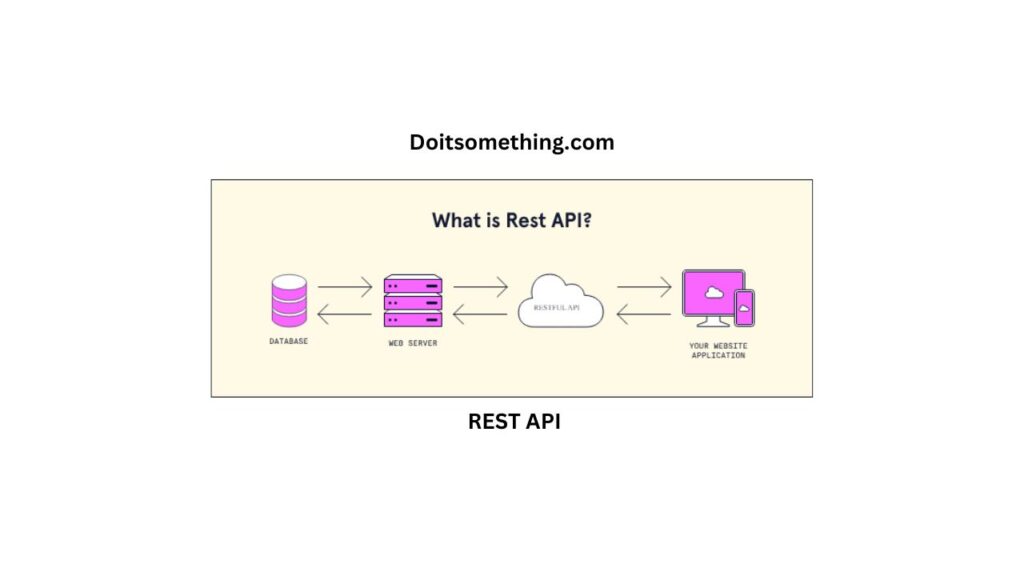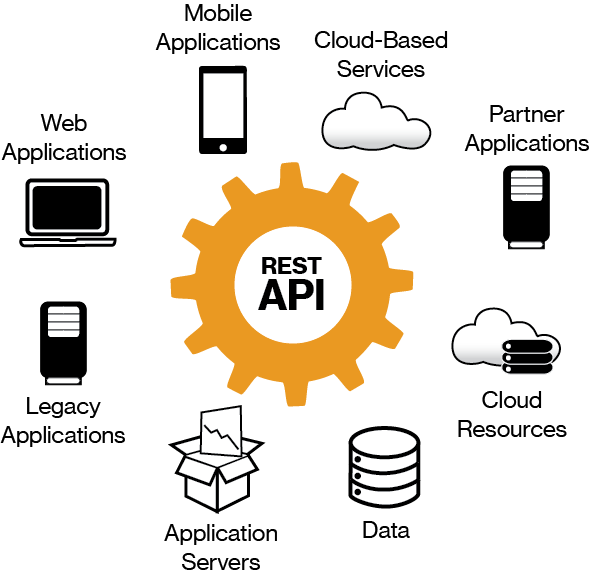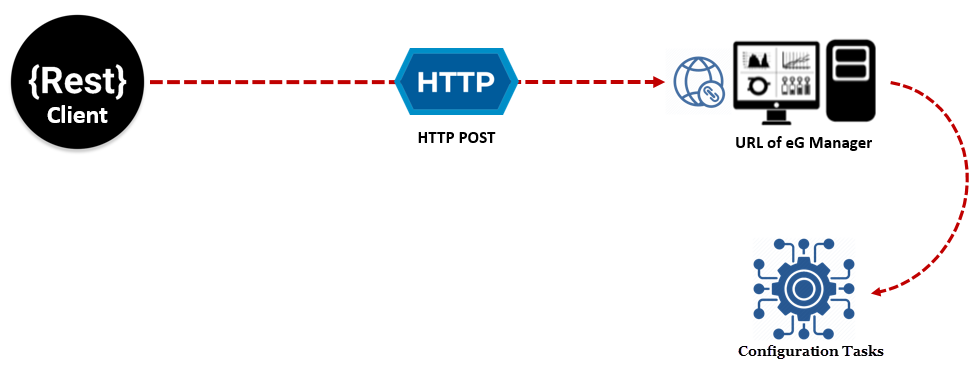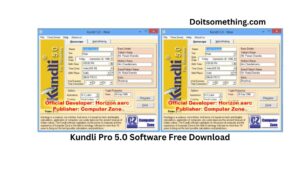What is REST API? – REST API Explained [2023]

What is REST API
What is REST API
Did you know about What is REST API If yes, then we got some information about all the. What is REST API Read to more.
REST (Representational State Transfer) is a software architectural style that lays out a set of constraints for the architecture of Internet-scale distributed hypermedia systems such as the World Wide Web.
In essence, the constraints of REST allow a developer to break down a complex transaction into small modules, each addressing an underlying part of the transaction. This modularity makes it easier to build and integrate a REST-based application.
To be a RESTful application, the system must support four basic operations: GET, POST, PUT and DELETE. These operations define the structure and meaning of a request. For example, a GET request sends a message to the server asking it to return data that corresponds to the resource ID specified in the URL. The response contains a representation of the resource, including its state at that time.
Using REST, developers can design a layered system architecture that uses one server to host the APIs, another to store and manage the data, and yet another to authenticate requests. The architecture also allows for caching to reduce network traffic and make applications more responsive.
Unlike SOAP, which is based on the XML protocol and requires a special parser for all devices, REST APIs use the HTTP protocol that is widely available across all devices. This makes it easy for developers to create and integrate a REST-based application, even on mobile devices such as iOS, Android or Windows Phone. REST also supports JSON, a simple format for representing information. This allows the developer to use a simple text editor to develop an application without having to learn complicated XML syntax.
REST design principles
- Client-Server Architecture: The client and server are separate entities that communicate over a network. The client handles the user interface and user experience, while the server handles processing requests, managing resources, and providing responses.

- Uniform Interface: A uniform interface simplifies the architecture and promotes loose coupling between the client and server. It consists of the following elements:
- Resource Identification: Each resource is uniquely identified by a URI (Uniform Resource Identifier).
- Resource Manipulation through Representations: Resources are manipulated using standard HTTP methods such as GET, POST, PUT, PATCH, and DELETE. The representation of a resource can be in different formats like JSON or XML.
- Self-descriptive Messages: The messages exchanged between the client and server should include enough information to understand the message’s meaning and how to process it. This can include using media types, headers, and status codes effectively.
- Hypermedia as the Engine of Application State (HATEOAS): The server includes hypermedia links in the responses, allowing clients to discover and navigate the available resources dynamically.
- Stateless Caching: Responses from the server can be cached by the client or intermediary systems (such as proxies) to improve performance and reduce server load. Cacheability is controlled using HTTP cache headers.
- Layered System: The architecture can be composed of many layers, where each layer provides specific functionality and hides the complexity from other layers. This promotes modularity, scalability, and allows for the introduction of intermediaries (such as load balancers or proxies) without affecting the client or server.
- Code-On-Demand (Optional): Servers can optionally provide executable code to be executed by the client. This principle is not commonly used in REST APIs and is considered optional.
What Are the Benefits of RESTful APIs?
REST APIs allow developers to separate their project into components that can be independently developed. This allows for scalability and flexibility.
This is done by separating concerns like user interface and data storage. This also improves scalability by decoupling server components. This is achieved through REST’s layered design structure.
Performance
APIs are the communication protocol that allows different technologies to work together. Its uniform interface allows systems to communicate regardless of technology, with the server responding to requests with resource representation in XML or JSON format.
For example, an agency with many software applications in HR, finance, sales and support, marketing, production, and QA may use a RESTful API to communicate with each other. This reduces the need for the leadership to move between programs and get a high-level overview of the company’s data.
Moreover, the statelessness of REST APIs makes caching easier. It means that the servers do not have to remember all past and future requests, thereby reducing the omit load on the server and increasing its performance. This is important for web applications that need state, such as e-commerce websites that keep track of purchases and inventory. Also, REST allows the use of JavaScript for front-end implementation, which speeds up client applications.
Scalability
Due to the separation between client and server, REST APIs are easy to scale for many development environments. They can be used by a web project, iOS app, or IoT device. They are also lightweight, which means they need less bandwidth to communicate with servers. Also, they are stateless, which reduces the number of trips between the client and the server.
REST provides a way for developers to create applications that work with any type of technology without knowing its internal implementation. This is important because it allows for flexibility and ensures that any component can be redeployed if it needs to be updated. Also, the REST architecture is layered, which helps make it more scalable and flexible. This design makes it easy to upgrade components in the middle of a process, which can reduce latency. It also makes it possible to install code on demand, which can reduce the number of requests that are sent to the server.
Flexibility
REST breaks down a transaction into small modules, each of which addresses a different part of the process. This helps improve scalability and provides flexibility to work with various platforms and languages.
It also allows the server to cache data, allowing users to access information quickly and reduce bandwidth consumption. Caching is particularly helpful for frequently accessed pages that are updated often.
Unlike SOAP, REST doesn’t dictate specific technologies or platform requirements. Instead, it introduces best practices for API developers to follow when building their systems. These are known as architectural constraints.
Uniform interface – Regardless of whether the client is a software application, a browser, or a mobile app, it must have a uniform way to communicate with the server. This ensures that all requests and responses are understood without any confusion or miscommunication. It also makes it easy for clients to reuse information between different applications. The uniform interface is achieved through four architectural constraints: identification of resources; manipulation of resources through representations; self-descriptive messages; and hypermedia as the engine of application state.
Security
There are several benefits to using RESTful APIs. For one, they offer scalability by eliminating the need for an entire product to be developed from scratch. They also allow for flexibility and portability because they can work across different syntaxes and platforms. Also, they are highly caching-friendly, allowing the server to reduce the number of requests by serving data from the cache.
Another benefit of RESTful APIs is their security. Because the protocol enables HTTPS, users can use it to encrypt information and prevent man-in-the-middle attacks. It also ensures that the data has not been tampered with in transit, providing integrity protection.
Finally, RESTful APIs are easy to integrate with existing websites. They use HTTP and JavaScript Object Notation (JSON), making them compatible with web front ends. This makes them easier to use than XML-based web APIs. They also need less bandwidth, which is especially helpful for sites with limited resources. They are also lightweight and easy to use in a browser.
How do REST APIs work?
- Client-Server Communication: RESTful APIs follow a client-server communication model. The client, which can be a web browser, mobile application, or any other software, initiates requests to the server. The server, in turn, processes the requests and sends back responses.
- Resource Identification: RESTful APIs expose resources, which are the key entities the API represents, such as users, products, or articles. Each resource is uniquely identified by a URI (Uniform Resource Identifier), which serves as an endpoint. Clients use these URIs to specify the target resource for their requests.

- HTTP Methods: RESTful APIs use the standard HTTP methods to perform operations on resources. The commonly used methods are:
- GET: Retrieves the representation of a resource.
- POST: Creates a new resource.
- PUT: Updates an existing resource with a complete replacement.
- PATCH: Updates an existing resource with partial modifications.
- DELETE: Removes a resource.
- Clients include the appropriate HTTP method in their requests to say the desired operation on the resource.
- Request and Response Formats: RESTful APIs typically use common data formats for representing the resources in requests and responses. JSON (JavaScript Object Notation) is the most widely used format, but XML (eXtensible Markup Language) is also used in some cases. Clients can include more headers to specify the content type they accept or expect in the response.
- Stateless Interactions: RESTful APIs are stateless, meaning that each request from the client to the server must contain all the necessary information to understand and process the request. The server does not store any client state between requests. Any required authentication or session information is usually included in the request headers.
What does the RESTful API client request contain?
A RESTful API client request typically contains several components that provide the necessary information for the server to understand and process the request. These components include:
1 : HTTP Method: The client specifies the HTTP method (also known as the HTTP verb) in the request to say the desired operation on the resource. Commonly used HTTP methods in RESTful APIs are:
- GET: Used to retrieve a representation of a resource.
- POST: Used to create a new resource.
- PUT: Used to update an existing resource with a complete replacement.
- PATCH: Used to update an existing resource with partial modifications.
- DELETE: Used to remove a resource.
2 : Headers: The client can include various headers in the request to provide more information or instructions to the server. Some commonly used headers in RESTful API requests are:
- Content-Type: Specifies the format of the request payload (e.g., JSON, XML).
- Accept: Specifies the desired response format.
- Authorization: Provides authentication information, such as tokens or credentials.
- Cache-Control: Controls caching behavior for the response.
Request Body/Payload: In some cases, the client includes a request body or payload to send more data to the server. This is common for operations like creating or updating a resource. The request body is usually formatted using the specified Content-Type header, such as JSON or XML.
Query Parameters: The client can include query parameters in the URL to provide more information or filter the results of the request. Query parameters are appended to the URL using the ? symbol and separated by & symbols.
Path Parameters: The client can include path parameters in the URL to specify dynamic parts of the resource path. Path parameters are typically denoted by placeholders within curly braces {} in the URL.
What are RESTful API authentication methods?
- API Keys: API keys are unique identifiers that clients include in the request headers or query parameters for authentication. The server verifies the validity of the API key to allow or deny access to the requested resource. API keys are typically long alphanumeric strings generated by the server and assigned to each client.

- OAuth 2.0: OAuth 2.0 is an industry-standard authorization framework that allows clients to get limited access to resources on behalf of a user. It involves three parties: the client application, the resource owner (user), and the authorization server. The client obtains an access token from the authorization server and includes it in the request headers to access protected resources.
- Basic Authentication: Basic Authentication involves sending the client’s credentials (username and password) in the request headers using Base64 encoding. The server validates the credentials to authenticate the client. Although simple, Basic Authentication should be used over secure connections (e.g., HTTPS) as credentials are transmitted in every request.
- Token-based Authentication: Token-based authentication involves issuing and validating tokens for each client. The client typically provides credentials (username and password) to the server, which then issues an authentication token. The client includes this token in next requests for authentication.
- OpenID Connect: OpenID Connect is an authentication layer built on top of OAuth 2.0. It provides authentication as well as user information and identity assertions. It allows clients to verify the identity of the end-user based on the authentication performed by an authorization server.
Also Read About Spoof Paytm Apk Download Latest Version For Android
FAQ – What is REST API
What is a REST API? An API, or application programming interface, is a set of rules that define how applications or devices can connect to and communicate with each other. A REST API is an API that conforms to the design principles of the REST, or representational state transfer architectural style.
It is an architectural style that defines a set of rules in order to create Web Services. In a client-server communication, REST suggests to create an object of the data requested by the client and send the values of the object in response to the user.
They don’t need more code. They need fast feedback to decide whether or not to proceed with their software changes in production.
Conclusion
REST (Representational State Transfer) is an architectural style for software that specifies many limitations for the design of distributed hypermedia systems at the Internet scale, like the World Wide Web.
REST’s limitations essentially enable developers to split up complex transactions into smaller modules, each of which addresses a different aspect of the transaction.
A REST-based application can be built and integrated more quickly thanks to this versatility.
The system must handle the following four operations to qualify as a RESTful application: GET, POST, PUT, and DELETE.
We hope that this article has helped you to know the What is REST API If you have any questions then let us know in the comment section. Thanks for reading.:








1 thought on “What is REST API? – REST API Explained [2023]”